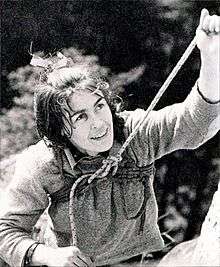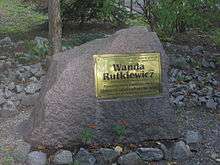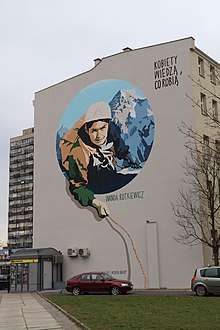Wanda Rutkiewicz
Wanda Rutkiewicz (née Błaszkiewicz) (Polish pronunciation: [/ˈvanda rutˈkʲevitʂ/] 4 February 1943 – 12–13 May 1992) was a Polish mountain climber and computer engineer.[1] She was the first woman to reach the summit of K2 and the third woman to climb Mount Everest.[2][3]
Wanda Rutkiewicz | |
|---|---|
 Wanda Rutkiewicz climbing on Góry Sokole (Falcon Mountains) in 1968 | |
| Born | Wanda Błaszkiewicz 4 February 1943 |
| Died | 13 May 1992 (aged 49) |
| Nationality | Polish |
| Occupation | Mountaineer |
| Known for | First woman to successfully climb K2 |
Early life
Wanda Rutkiewicz was born into a Polish family in Plungė, Lithuania. After World War II, her family chose to leave for Poland, settling in Wrocław in southwestern Poland's Recovered Territories, where she graduated from Wroclaw University of Technology as an electrical engineer.
Wanda Rutkiewicz rode a Junak, the heaviest Polish motorcycle, which indirectly contributed to her interest in climbing. One summer's day in 1961 it ran out of fuel. She started waving to people passing on the road to seek their assistance; a motorcyclist who stopped to help was travelling with a colleague, Bogdan Jankowski, who had been climbing for two years. This chance meeting resulted in them climbing together near Janowice Wielkie in the Falcon Mountains (Polish: Góry Sokole).
Climbing career
Her first major expedition was to the Pamir Mountains with Andrzej Zawada, which she found unpleasant due to her difficult relationships with the male climbers.[4]
After returning she began to lead her own expeditions, including a number of all-female ones, and became known for her blunt leadership style.[4]
On 16 October 1978, she became the first Pole, the third woman (after Junko Tabei and Phantog in 1975), and the first European woman to reach the summit of Mount Everest.[5] In 1986 she became the first woman to successfully climb K2, which she did without supplemental oxygen, as part of a small expedition led by Lilliane and Maurice Barrard. Her triumph was marred when both the Barrards died during the descent, becoming two of 13 climbers to die on K2 that summer.[6]

Rutkiewicz's goal was to become the first woman to reach the summits of all 14 of the eight-thousanders. During her climbing career she successfully climbed the following mountains:
- 1975 – Gasherbrum III [7]
- 1978 – Mount Everest
- 1985 – Nanga Parbat
- 1986 – K2
- 1987 – Shishapangma
- 1989 – Gasherbrum II
- 1990 – Gasherbrum I
- 1991 – Cho Oyu
- 1991 – Annapurna I
- 1992 – Kangchenjunga (uncertain)
Death
While climbing Kangchenjunga, 49-year-old Rutkiewicz was last seen alive by Mexican climber Carlos Carsolio. She was sheltering at high altitude on the north-west face, during her attempted ascent of what would have been her ninth eight-thousander. Rutkiewicz was physically weakened and decided against descending. Carsolio said he didn't have the mental strength to convince her to descend because he was weakened as well.[8]
It was thought that her body had been found on the south-west face of the mountain in 1995 by Fausto de Stefani, Marco Galezzi and Silvio Mondinelli, suggesting that she had climbed up the north-west ridge to a point very close to the summit before falling down the south-west side. However, more detailed analysis of the findings by the Italian climbers, such as colour of clothing and presence of Bulgarian-made tablets with the body, indicate that most likely it was the body of Bulgarian climber Yordanka Dimitrova, who was killed by an avalanche on the south-west face of Kangchenjunga in October 1994. It is not known if Rutkiewicz reached the summit of Kangchenjunga. If she did so, she would have been the first woman to reach the top of the world's three highest mountains. Rutkiewicz's body has still not been found.
Commemoration
In Wrocław - street at the Gaj housing estate, mural, elementary and junior high school named after Wanda Rutkiewicz.
On 16 October 2019, Wanda Rutkiewicz was the subject of the daily Google Doodle on the forty-first anniversary of her ascent of Mount Everest.[9] The image shows her climbing snowy peaks on the railing rope.[10]
Bibliography
- Reinisch, Getrude, Wanda Rutkiewicz: A Caravan of Dreams (2000) ISBN 0-9538631-0-7
- Freedom Climbers ISBN 978-1-926855-60-8 Freedom Climbers by Bernadette McDonald
References
- Martina Gugglberger (24 April 2016). "Wanda Rutkiewicz – crossing boundaries in women's mountaineering". Sport in Society. 20 (8): 1059–1076. doi:10.1080/17430437.2016.1175139.
- "„Wyglądała, jakby wróciła z Księżyca". 30 lat temu Rutkiewicz stanęła na K2". www.tvp.info (in Polish). 23 June 2016. Retrieved 15 November 2019.
- "Strona 3 Pruszkowskiej Drużyny Harcerskiej". 3pdh.pruszkow.zhp.pl. Retrieved 15 November 2019.
- Michael Keller (23 August 2017). "Death Before Failure: Wanda Rutkiewicz & The Golden Age of Polish Mountaineering". Culture.pl. Retrieved 15 June 2018.
- Jordan, Jennifer (2006). Savage Summit: The Life and Death of the First Women on K2. HarperCollins. p. 40. ISBN 978-0-06-058716-1.
- Jordan, Jennifer (2006). Savage Summit: The Life and Death of the First Women on K2. HarperCollins. pp. 84–94. ISBN 978-0-06-058716-1.
- "Alison Chadwick, the second wife of Onyszkiewicz, who died in the mountains. They met in the Tatra Mountains, together they captured the Himalayas". naTemat.pl. Retrieved 11 June 2018.
- Jordan, Jennifer (2006). Savage Summit: The Life and Death of the First Women on K2. HarperCollins. pp. 171–174. ISBN 978-0-06-058716-1.
- "Who was Wanda Rutkiewicz, the Polish mountain climber who conquered Mount Everest?". The Independent. 2019-10-16. Retrieved 2019-10-16.
- "Celebrating Wanda Rutkiewicz". www.google.com. Retrieved 2019-10-16.
External links
- Everest History: Wanda Rutkiewicz
- Biography of Wanda Rutkiewicz
- CLIMB, podcast from Culture.pl's Stories From The Eastern West about Rutkiewicz.
